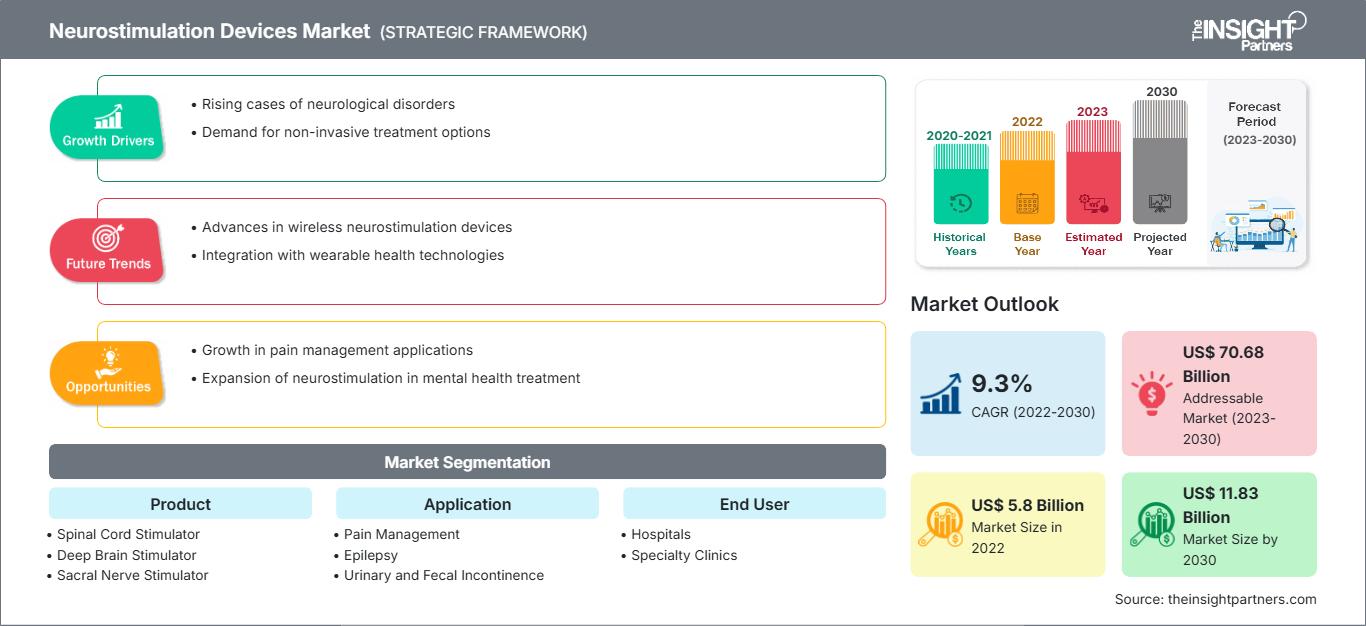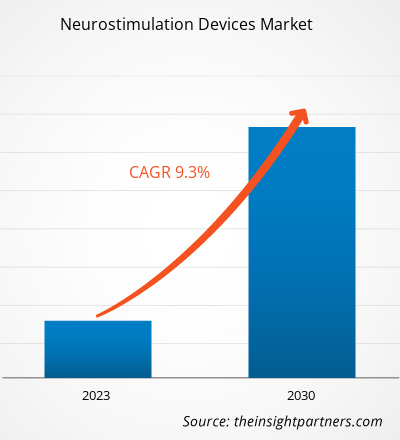[研究报告] 神经刺激设备市场预计将从 2022 年的 58.0247 亿美元增长到 2030 年的 118.2595 亿美元;预计 2022 年至 2030 年的复合年增长率为 9.3%。
市场洞察和分析师观点:
神经刺激设备是旨在调节神经系统活动的医疗设备。它们用于治疗各种神经系统疾病和慢性疼痛。神经刺激设备有几种类型,包括脊髓刺激器、深部脑刺激器、迷走神经刺激器和周围神经刺激器。这些设备可以显著改善各种神经系统疾病患者的生活质量。神经系统疾病患病率的上升和脊髓损伤病例的增加是市场发展的关键因素。然而,缺乏专业人才阻碍了神经刺激设备市场的增长。
增长动力和挑战:
老年人群易患神经系统疾病。影响老年人的常见神经系统疾病有神经病、帕金森病、阿尔茨海默病、肌张力障碍等。根据美国国立卫生研究院 (NIH) 的数据,世界人口的 8.5%(即约 6.17 亿人)年龄在 65 岁及以上。美国和加拿大等国家与老年人口增长相关的运动障碍和精神疾病患病率很高。根据帕金森基金会的数据,帕金森症状在平均 60 岁时很常见。
加拿大心理学会指出,强迫症 (OCD) 影响加拿大约 2% 的人口。世界卫生组织 (WHO) 指出,癫痫是一种引起癫痫发作的神经系统疾病,影响着全球约 5000 万人。美国神经病学学会 (ANSCI) 的数据显示,中风是美国第三大死亡原因,阿尔茨海默病位列第六。同一来源的统计数据显示,近一百万美国人患有帕金森病,每年至少报告 6 万例新发病例。神经系统疾病的发病率不断上升,加上抑郁症和慢性疼痛等生活方式相关疾病,导致人们越来越多地采用高科技产品。
据 WHO 称,神经系统疾病约占全球疾病负担的 6.3%。此外,该来源还指出,神经系统疾病是全球主要死亡原因之一。它们在发达国家造成 13.2% 的死亡,在中低收入国家造成 16.8% 的死亡。高死亡率和疾病负担使得临床迫切需要整合长期解决方案。此外,人们越来越意识到神经系统疾病的巨大负担,这也增加了对神经刺激器作为一种治疗方法的需求。
因此,越来越多的老年人口易患神经系统疾病,疾病患病率不断上升,以及对神经系统疾病巨大负担的认识不断提高,推动了神经刺激设备市场规模的增长。
自定义此报告以满足您的要求
您将免费获得任何报告的定制,包括本报告的部分内容,或国家级分析、Excel 数据包,以及为初创企业和大学提供超值优惠和折扣
神经刺激设备市场: 战略洞察

-
获取本报告的主要市场趋势。这个免费样本将包括数据分析,从市场趋势到估计和预测。
报告细分和范围:
全球神经刺激设备市场根据产品、应用和最终用户进行细分。根据产品,市场细分为脊髓刺激器、深部脑刺激器、骶神经刺激器和迷走神经刺激器。在应用方面,神经刺激设备市场细分为疼痛管理、癫痫、尿失禁和大便失禁、帕金森病等。根据最终用户,神经刺激设备市场细分为医院、专科诊所和其他。根据地域,神经刺激设备市场细分为北美(美国、加拿大和墨西哥)、欧洲(德国、法国、意大利、英国、俄罗斯和欧洲其他地区)、亚太地区(澳大利亚、中国、日本、印度、韩国和亚太其他地区)、中东和非洲(南非、沙特阿拉伯、阿联酋以及中东和非洲其他地区)和南美洲和中美洲(巴西、阿根廷以及南美洲和中美洲其他地区)。
分段分析:
根据产品,神经刺激设备市场细分为脊髓刺激器、深部脑刺激器、骶神经刺激器、迷走神经刺激器等。脊髓刺激器细分市场在 2022 年占据最大市场份额,预计在 2022 年至 2030 年期间的复合年增长率将更高。脊髓刺激可以治疗因各种原因引起的严重慢性疼痛患者,包括背部手术失败/蛛网膜炎、神经性疼痛/神经病变以及复杂性区域疼痛综合征/反射性交感神经营养不良症。一些 SCS 设备使用低频电流通过一种称为感觉异常的轻微刺痛来改变疼痛感。其他脊髓刺激 (SCS) 设备使用高频或突发脉冲来掩盖疼痛,而不会产生刺痛感。
脊髓刺激已成为介入性疼痛管理的基础,用于治疗各种慢性疼痛。自 1967 年首次问世以来,该技术取得了长足进步,催生了微创置入和内置电池的新技术。例如,2023 年 5 月,雅培获得美国食品药品监督管理局 (FDA) 批准,其 SCS 设备可用于治疗无法接受背部手术的患者的慢性背痛(即非手术背痛)。此外,2023 年 8 月,美敦力公司 (Medtronic plc) 的 Inceptiv 闭环可充电脊髓刺激 (SCS) 获得了 CE 标志认证。这是美敦力首款提供闭环功能的脊髓刺激 (SCS) 设备,该功能可感知每个人独特的生物信号,并根据需要随时调整刺激,使治疗与日常生活活动协调一致。这些发展推动了SCS的普及,从而推动了全球神经刺激设备市场的增长。
神经刺激设备市场按应用细分为疼痛管理、癫痫、大小便失禁、帕金森病等。疼痛管理领域在2022年占据了最大的市场份额,预计在2022年至2030年期间将实现更高的复合年增长率。
慢性疼痛影响老年人、创伤和手术患者、接受不同疗法的患者以及与各种身心疾病相关的人群。根据美国疾病控制与预防中心(CDC)的数据,背痛是就诊的第二大原因,约60%至80%的人在一生中都会经历腰痛,这是住院或手术的主要原因之一。
神经刺激是一种更安全、更有效的缓解慢性疼痛的方法,已被广泛采用。许多生物科技公司正在推出神经刺激器,帮助阿片类药物成瘾者克服疼痛和其他戒断症状。例如,2021年4月,领先的医疗器械公司Spark Biomedical推出了一款名为Sparrow Therapy System的新型神经刺激装置,帮助阿片类药物成瘾者缓解戒断症状。该装置使用低剂量电流刺激内啡肽的产生,有助于缓解患者在戒断期间的疼痛和恐惧。此外,2021年3月,Mainstay Medical在澳大利亚推出了一款用于治疗慢性腰痛(CLBP)的植入式神经刺激装置ReActiv8。该装置可能有助于治疗与腰椎多裂肌功能障碍相关的难治性CLBP的成年人。2023年1月,美国食品药品监督管理局(FDA)批准了雅培的Proclaim XR脊髓神经刺激系统,该系统可帮助糖尿病周围神经病变患者控制慢性疼痛。因此,上述应用和好处对 2022 年至 2030 年的神经刺激设备市场产生积极影响。
区域分析:
根据地理位置,神经刺激设备市场分为五个主要区域:北美、欧洲、亚太地区、南美和中美以及中东和非洲。对北美市场的分析主要集中在三个主要国家——美国、加拿大和墨西哥。2022 年,美国占据北美神经刺激设备市场的最大份额。由于神经系统疾病患病率不断上升、研发支出高昂、美国食品药品监督管理局 (FDA) 的产品批准以及技术进步,预计在预测期内美国将占据北美神经刺激设备市场的最大份额。在美国,神经血管疾病的发病率正在显著上升,并正在成为主要的死亡原因。帕金森病 (PD) 等神经系统疾病发病率的上升、人们对神经系统疾病认识的提高以及对颅脑刺激器开发投资的不断增加,是推动美国整体神经刺激设备市场发展的主要因素。据观察,深部脑刺激 (DBS) 设备能够有效控制与帕金森病相关的震颤。多巴胺水平低和其他遗传因素是导致帕金森病的主要原因之一。根据美国阿尔茨海默病协会发表的一项名为《2022 年阿尔茨海默病事实与数据》的研究,2022 年,近 650 万 65 岁及以上的美国人被诊断患有阿尔茨海默病。预计到 2060 年,这一数字将上升到 1380 万。帕金森基金会预计,到 2030 年,美国帕金森病患者人数将增至 120 万。技术进步和新产品的推出推动了神经刺激设备市场的发展。2020 年 1 月,雅培公司的神经刺激器 Infinity DBS 系统获得美国食品药品监督管理局 (FDA) 批准,用于治疗帕金森病。该系统可以针对大脑中与帕金森病症状相关的特定区域——内苍白球 (GPi) 进行靶向治疗。因此,神经系统疾病的日益流行和技术的进步推动了美国神经刺激设备市场的增长。
竞争格局和主要公司:
神经刺激设备市场的发展被概括为有机增长和无机增长战略。各公司专注于有机增长战略,例如产品发布、扩张、增强和迁移。市场上的无机增长战略包括并购、合作伙伴关系和协作。这些活动为神经刺激设备市场参与者的业务和客户群扩张铺平了道路。
- 2023年8月,Mainstay Medical Holdings plc 宣布其用于治疗顽固性慢性腰痛的 ReActiv8 RESTORE 随机临床研究的受试者入组工作已完成。该研究旨在与优化的医疗管理进行直接比较,以检验以下假设:在现有护理模式中添加 ReActiv8 恢复性神经刺激疗法可显著改善背痛相关的残疾。
- 2023 年 4 月,Synapse Biomedical, Inc. 宣布美国食品药品监督管理局 (FDA) 批准 NeuRx 膈肌起搏系统 (NeuRx DPS) 用于依赖机械通气的脊髓损伤患者。PMA 是 FDA 要求的最严格的器械上市申请类型。
- 2023 年 8 月,雅培宣布美国食品药品监督管理局 (FDA) 批准其采用 FlexBurst360 疗法的新型 Proclaim Plus 脊髓刺激 (SCS) 系统。FlexBurst360 疗法是雅培专有的 BurstDR 刺激的下一代产品,可覆盖躯干和/或四肢的六个区域的疼痛。它可以随着患者治疗需求的变化而调整程序。
- 2023年5月,雅培宣布美国食品药品监督管理局 (FDA) 批准其脊髓刺激 (SCS) 设备,用于治疗未接受过或没有资格接受背部手术的患者的慢性背痛,即非手术性背痛。
- 2021年1月,美敦力公司获得美国食品药品监督管理局 (FDA) 批准其高性能免充电植入式神经刺激器 (INS) Vanta,其设备寿命可优化至11年。在同等设置下,Vanta 神经刺激器的使用寿命几乎是竞争对手原发性细胞刺激器的两倍。
- 2022年1月,美敦力公司获得美国食品药品监督管理局 (FDA) 批准其 Intellis 可充电神经刺激器和 Vanta 免充电神经刺激器用于治疗与糖尿病周围神经病变 (DPN) 相关的慢性疼痛。
神经刺激设备市场区域洞察
The Insight Partners 的分析师已详尽阐述了预测期内影响神经刺激设备市场的区域趋势和因素。本节还讨论了北美、欧洲、亚太地区、中东和非洲以及南美和中美洲的神经刺激设备市场细分和地域分布。
神经刺激设备市场报告范围
| 报告属性 | 细节 |
|---|---|
| 市场规模 2022 | US$ 5.8 Billion |
| 市场规模 2030 | US$ 11.83 Billion |
| 全球复合年增长率 (2022 - 2030) | 9.3% |
| 历史数据 | 2020-2021 |
| 预测期 | 2023-2030 |
| 涵盖的领域 |
By 产品
|
| 覆盖地区和国家 |
北美
|
| 市场领导者和主要公司简介 |
|
神经刺激设备市场参与者密度:了解其对业务动态的影响
神经刺激设备市场正在快速增长,这得益于终端用户需求的不断增长,而这些需求的驱动因素包括消费者偏好的演变、技术进步以及对产品优势的认知度的提升。随着需求的增长,企业正在扩展产品线,不断创新以满足消费者需求,并抓住新兴趋势,从而进一步推动市场增长。

- 获取 神经刺激设备市场 主要参与者概述
公司简介
- 美敦力公司
- 波士顿科学公司
- 雅培实验室
- Nevro Corp
- LivaNova Plc
- Synapse Biomedical Inc
- Nalu Medical, Inc
- ElectroCore公司
- MicroTransponder 公司
- Mainstay Medical
- 历史分析(2 年)、基准年、预测(7 年)及复合年增长率
- PEST和SWOT分析
- 市场规模、价值/数量 - 全球、区域、国家
- 行业和竞争格局
- Excel 数据集
近期报告
客户评价
购买理由
- 明智的决策
- 了解市场动态
- 竞争分析
- 客户洞察
- 市场预测
- 风险规避
- 战略规划
- 投资论证
- 识别新兴市场
- 优化营销策略
- 提升运营效率
- 顺应监管趋势






















 获取免费样品 - 神经刺激设备市场
获取免费样品 - 神经刺激设备市场